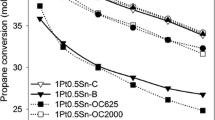Abstract
Temperature programmed oxidation of coke deposited on Pt based propane dehydrogenation catalysts reveals that the deposited coke can be categorised into three groups according to their burning temperatures. When coke was separated from the catalyst, however, only one TPO peak could be observed. Experimental results suggest that γ-Al2O3 enhances the coke burning process by increasing coke surface area contacts to oxygen. Pt may also act as a catalyst for the coke combustion reaction. Experiments also show that changing dehydrogenation reaction temperature, variation of H2/HC ratios, addition of only Sn or Sn and an alkali metal (Li, Na and K) can significantly affect the amount of each coke formed. Sample weight used in the temperature programmed oxidation (TPO) experiment also affects the resolution of TPO spectrum.
Similar content being viewed by others
References
Atchara Saengpoo, “Combustion of Coke on Dehydrogenation Catalysts”, M. Eng. Theses, Chulalongkorn University (1995).
Barbier, J. B., Corro, G. and Zhang, Y., “Coke Formation on Platinum-Alumina Catalyst of Wide Varying Dispersion”,Appl. Catal.,13, 245 (1985).
Barbier, J. B., Marecot, P., Martin, N., Elassal, L. and Maurel, R., “Selective Poisoning by Coke Formation on Pt/Al2O3”, Catalyst Deactivation (Delmon, B. and Froment, G. F. eds), Elsevier, Amsterdam, p. 53 (1980).
Bartholdy, J., Zenthen, P. and Masooth, F. E., “TemperatureProgrammed Oxidation Studies of Aged Hydroprocessing Catalysts”,Appl. Catal. A,129, 33 (1995).
Biswas, J., Gray, P. G. and Do, D. D., “The Reformer Lineout Phenomenon and Its Fundamental Importance to Catalyst Deactivation”,Appl. Catal.,32, 249 (1987).
Bualom Jaikaew, “Effect of Alkali Metals in Dehydrogenation Catalysts for Coke Reduction”, M. Eng. Theses, Chulalongkorn University (1995).
Carlos, L. P. and Jose, M. P., “Comparison of Coke Burning on Catalysts Coked in a Commercial Plant and in the Laboratory”,Ind. Eng. Chem. Res.,28, 1785 (1989).
Larsson, M., Hulten, M., Blekkan, E. and Andersson, B., The Effect of Reaction Conditions and Time on Stream on the Coke Formed During Propane Dehydrogenation”,J. Catal.,164, 44 (1996).
Liwu, L., Tao, Z., Jingling, Z. and Zhusheng, Z., “Dynamic Process of Carbon Deposition on Pt and Pt-Sn Catalysts for Alkane Dehydrogenation”,Appl. Catal.,67, 11 (1990).
Marecot, P., Akhachane, A. and Barbier, J., “Coke Deposition on Supported Palladium Catalysts”,Catal. Lett.,36, 37 (1996).
Nonglak Pinitniyom, “Characterization of Coke on Dehydrogenation Catalysts”, M. Eng. Theses, Chulalongkorn University (1996).
Pieck, C. L., Jablonski, E. L., Verderone, R. J. and Parera, J. M., “Selective Regeneration of Catalytic Functions of Pt-Re-S/Al2O3-Cl During Coke Burning”,Appl. Catal.,56, 1 (1989).
Querini, C. A. and Fung, S. C., “Coke Characterisation by Temperature Programmed Techniques”,Catal. Today,37, 277 (1997).
Querini, C. A. and Fung, S. C., “Temperature-Programmed Oxidation Technique: Kinetics of Coke-O2 Reaction on Supported Metal Catalysts”,Appl Catal. A,117, 53 (1994).
Reyes, P., Oportus, M., Pecchi, G., Frety, R. and Moraweck, B., “Influence of the Nature of the Platinum Precursor on the Surface Properties and Catalytic Activity of Alumina-Supported Catalysts”,Catal. Lett.,37, 193 (1996).
Silipoln Kunatippapong, Determination of Irreversible Coke Deposition of Platinum Active Site of Propane Dehydrogenation Catalyst”, D. Eng. Theses, Chulalongkorn University (1995).
Tao, Z., Jingling, Z. and Liwu, L., “Relation Between Surface Structure and Carbon Deposition on Pt/Al2O3 and Pt-Sn/Al2O3 Catalysts”, Studies in Surface Science and Catalyst, Elsevier, Amsterdam,34, 143 (1991).
Author information
Authors and Affiliations
Corresponding author
Rights and permissions
About this article
Cite this article
Mongkhonsi, T., Prasertdham, P., Saengpoo, A. et al. Roles of Pt and alumina during the combustion of coke deposits on propane dehydrogenation catalysts. Korean J. Chem. Eng. 15, 486–490 (1998). https://doi.org/10.1007/BF02707096
Received:
Accepted:
Issue Date:
DOI: https://doi.org/10.1007/BF02707096



